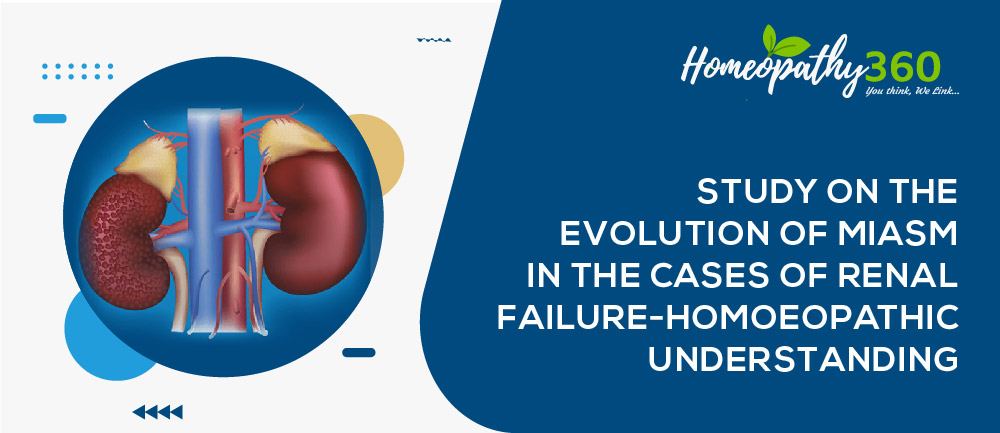
ABSTRACT
Dr Hahnemann’s discovery of miasm has expanded to dimension of understanding the causative factors of disease in depth. Evolution of disease patterns are better reflected and explained though the miasm understanding. It has widened the applicability of homoeopathic medicines to the extent of providing cure. Its role in the chronic nature of renal failure has great possibilities to provide better management and cure.
KEYWORDS
Miasm, renal failure.
ABBREVIATIONS
CKD: chronic kidney disease, GFR: glomerular filtration rate, GBM: glomerular basement membrane, PCT: proximal convoluted tubule.
INTRODUCTION
Homoeopathy is one of the fastest growing powerful alternative medicines available today which triggers the body’s own self healing abilities. Dr Hahnemann spent twelve years of his life investigating miasms which is responsible for both, acute and chronic diseases. For the cure, similarity of symptoms is not enough, apart from this similarity of miasms is also desired. Remedy should be based on the totality grouping of the disturbed or active, chronic miasm. 1
Hahnemann spent twelve years of his life to discover miasm analysing his relapse and uncured cases. Relapses were in changed form but the residual symptoms remained the same. Organon of Medicine mentioned this phenomenon as “RELIC OF DISEASE” in § 194.2
Allopathic perspective of the “disease” is that it is only an object which needs to be removed as they regard the organic abnormality as disease. Homoeopathic concept admits that it is never possible to know the disease-human knowledge will never go so far.3
The action of the miasms is to make gaps and breaches in nature that the debilitated life forces cannot repair. They deform the body, dull the intellect and destroy reason. They are co-workers with sin and with death. They are like enemies entrenched, attacking us at all our weak points, recede and advance and recede.4
Hahnemann discovered that the chronic diseases nearly always had a pattern that could be related to psora, sycosis, syphilis. 5 Psora is the real cause of all diseases- that all diseases are only temporary outbursts of latent psora. Psora alone is never able to cause any change in the structure. Structural changes do not come in all in, unless there is atleast one of the other two miasm, sycosis and syphilis. Two conditions are needed for structural changes: first is time; second is sycosis or syphilis, or both, against a psoric background.6
The disease states could be beautifully worked out on the framework of miasm and the patient understood better; it become easier to arrive at the remedy. Depending on the intensity of the roots, the person is carried through to the various stages of pathology. One should remember that it is not the pathology which shows the miasm but the state. The pathology per se is not as important as what is characteristic of the pathology in that individual. We have to find what is the state that indicates the miasm rather than finding the miasm on the basis of the pathology.7
With the constant evolution of the homoeopathy, the pathological symptoms have also been given importance which has been seen through Boger’s repertory. With the advancement of the pathological progress of the disease or natural history of the disease conditions can be well found and the stage of the pathological advancement of the disease can be diagnosed.
Signs and symptoms precede the pathological changes. With the natural course of disease, as the pathology advances so does the sign and symptoms changes or intensifies. Knowing the stage of pathology, the prognosis can be better understood and so does the condition of the patient better evaluated. Location, sensation, and modalities are the expression of symptom where location is the element in pathology. Pathological similarity is also needed along with symptom similarity.
A disease state is usually a combination of miasms with its main focus on one miasm.
Miasmatic interpretation of chronic kidney disease
Kidney develops from within the intermediate mesoderm, early nephrons develop from induction of primary mesenchymal cells.It is most highly differentiated organ in the body. The kidneys are important for maintaining the body’s internal balance, especially of water and minerals( sodium, potassium, chloride, phosphate, magnesium, sulphate, etc.); acid-base balance and removal of fuel or drug metabolites. 8 The kidneys also function as a part of the endocrine system and produce erythropoietin and calcitriol, thrombopoietin, renin and prostaglandin performing hemopoietic function, regulation of blood calcium level; regulation of blood pressure by regulating the volume of extracellular fluid and through Renin-angiotensin mechanism.9
Chronic kidney disease is defined as an abnormality of kidney structure or function for ≥ 3 months. The most common causes of CKD are diabetes mellitus, hypertension and glomerulonephritis. There is permanent and irreversible impairment of both- glomerular and tubular function of gradual onset of such severity that kidneys are no longer able to maintain the internal environment. The rate of progression is variable and it may take months or many years to reach end stage renal disease. This represents a stage of renal CKD where accumulation of toxins, fluid and electrolytes normally excreted by the kidney results in uraemic syndrome. This syndrome leads to death of the patient unless toxins are removed by any means.
Homoeopathic consideration of CKD observed through cases has built an understanding that the development of the disease itself is the ultimate. An individual case needs proper understanding of the circumstantial factors which led to the development of the disease. Miasmatic background has to be evolved in this manner. CKD is a representative chronic syndrome, since it is characterized by a gradual progression and multifactorial nature. Significant number of diseases can lead to the manifestation of CKD, and notably, many of them are idiopathic.
Considering the end stage renal disease, it is essentially syco-syphilitic in nature owing to nature of the symptoms. However the developmental stages of renal failure involves different pathological changes, and these changes will decide the miasmatic preponderance at that stage.
Pathophysiology
Diabetes mellitus – Renal involvement is one of the complication and a leading cause of death in diabetes( in about more than 10% of diabetics).Renal complications are more severe , develop early and more frequently in type1 diabetes mellitus (30-40% cases) than in type2 diabetes mellitus ( about 20% cases).Renal involvement in diabetics is a slow progressive process undergoing different stages. initially there is loss of autoregulation mechanism in kidney, with slight reduction in GFR, systemic hypertension as clinical finding. With progression there is renal hyperperfusion; hyperfilteration and endothelial damage in kidney leading to deposition of protein in mesangium causing glomerulosclerosis which ultimately without treatment leads to renal failure.There are four types of renal lesions found , which include diabetic glomerulosclerosis—of diffuse and nodular type; vascular lesion; diabetic pyelonephritis, and tubular lesion.
Diffuse glomerulosclerosis are one of the most common lesions. Pathological changes include thickening of GBM and there is diffuse increase in mesangial matrix with mild proliferation of mesangial cells, exudative lesions like capsular hyaline drops and fibrin caps present ( hyaline arteriosclerosis). Nodular lesion called kimmelstiel wilson lesion; nodules are ovoid or spherical laminated hyaline acellular mass located within lobule of glomerulus. With the enlargement of nodular lesion, it compreses capillaries and obliterate the glomerular tuft causing renal ischaemia which further cause tubular atrophy, interstitial fibrosis leading to small contracted kidney.
If diabetes is not controlled, patient become susceptible to bacterial infection, papillary necrosis leading to pyelonephritis. In untreated diabetes mellitus, who have extremely high blood sugar level, the epithelial cells of PCT develop extensive glycogen deposits appearing as vacuoles called armanni-ebstein lesion.10
Hypertension leads to thickening of the walls and narrowing of the arterial opening (atherosclerosis).Transmission of elevated pressure on unprotected glomerulus with ensuing hyperfilteration ana hypertrophy.This leads to inadequate blood flow to renal cells causing tubular atrophy, interstitial fibrosis and glomerular alteration. Scarring around glomeruli occurs.
Glomerular disease due to deposition of immune complex which results in injury to the glomerulus, proliferation of inflammatory process with release of growth factors, producing fibrotic changes collagenising leading irreversible changes. All these causes renal cortices to shrink, atrophy of tubules and hyalinisation of glomeruli.11
Miasmatic evolution of renal failure12
| Psoric stage | Sycotic stage | Syphilitic stage | |
| Symptoms in prodromal stage | Hypertension | Narrowness of blood vessels leads towards HTN | |
| Emotional disturbances like anxieties, anger, worries or grief, etc. | |||
| Symptoms of early stage | Retention of urine : when expose to cold weather , fright | Renal dropsy as in case of nephrotic syndrome | Secondary hypertension and malignant hypertension |
| Involuntary urination due to : sneezing, laughing, coughing | Thickening of glomerular basement membrane | ||
| Burning micturition due to dehydration | Excessive fats deposition | ||
| Urine: colourless, pale, copious | Hypertrophy of organs | ||
| Recurrent urinary tract infection | Accumulation of fluid in body | ||
| Albuminuria | Obesity; | ||
| Haematuria; chyluria | |||
| Myeloid hyperplasia | |||
| Symptoms of advanced stage | Glomerulosclerosis | Glomerulosclerosis | |
| Renal fibrosis | Renal fibrosis | ||
| Gouty kidney | Chronic renal failure with loss of nephron | ||
| Stricture of urethra | Complete atrophy of kidney | ||
| Destructive changes in vital organs |
Discussion and conclusion
Renal failure represents the ultimate condition of the pathological changes that has happened in the diseased individual. The predisposition to this condition is generally attributed to the miasmatic predominance. A miasm is the body’s predisposition for certain categories of diseases and something that hinders the action of the homeopathic remedy. A characteristic example in kidney failure is the structural and functional impairment of the nephrons, which are unable to maintain the body’s homeostasis. This could be true for patients with CKD, in which miasmatic conditions potentially affect the body’s structure. Accordingly, in some CKD cases, the behavior of the “sick” system is predefined by its composition. Thus proper evaluation of the ‘state’ is important for maisamatic diagnosis of the patient. This will help in the selection of similimum.
In conclusion, the multifactorial nature of CKD and the complexity of the human body should be approached both through the homeopathic theory of disease suppression, as well as that of miasms.
References:
- Allen, J.H.; The chronic miasms with repertory;Rearranged & augmented edition 2007; B.Jain Publishers(P) LTD.12th impression-2017;pg-291
- Hahnemann S; Organon of Medicine, fifth and sixth edition; Low price edition 2002; B.Jain Publishers (P) Ltd. 5th impression 2009; pg no-105-106.
- Banerjee, P.N.; Chronic disease its cause and cure; Reprint 1983; World homoeopathic links.; pg no-19
- Allen, J.H.; The chronic miasms with repertory;Rearranged & augmented edition 2007; B.Jain Publishers(P) LTD;12th impression 2017; pg no-16-17
- Sankaran R; The Substance Of Homoeopathy; Fourth edition; Homoeopathic Medical Publishers, Reprint in 2008.pg no-43-44
- Banerjee, P.N.; Chronic disease its cause and cure; Reprint 1983; World homoeopathic links.; pg no 295
- Sankaran R; The Substance Of Homoeopathy; Fourth edition; Homoeopathic Medical Publishers, Reprint in 2008.pg no-43-44
- Jameson L, Kasper D.L., Longo D.L., Fauci Anthony S., Hauser Stephen L.,Loscalzo Joseph et.al.; Harrison’s Principles of Internal Medicine; 20th edition; Mc Grew Hill Elsevier; 2018;pg no- 2111-2116
- Sembulingam K.,Sembulingam Prema;Essentials of Medical Physiology; 5th edition,2009;Jaypee Brothers Medical Publishers (P) LTD
- Mohan H; Textbook of Pathology; 6th edition,2010; Jaypee Brothers Medical Publisher (P) LTD.pg no-664-678
- Boon N.A.,Colledge Nicki R.,Walker Brian R., Hunter John A. A.; Davidson’s Principles and practice of Medicine; 20th edition;Elsevier Limited ,2006;pg no-487-489.
- Banerjee, P.N.; Chronic disease its cause and cure; Reprint 1983; World homoeopathic links; pg no-279-309.
About Author:
Dr Manila Kumari, PGT
R.B.T.S. Govt. Hom. Med.
College & Hospital, Bihar




